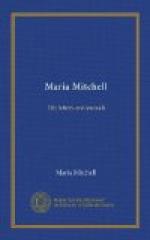“When I came away, he thanked me again for the visit, followed me into the anteroom, and made a low bow.”
In 1855 Mrs. Mitchell was taken suddenly ill, and although partial recovery followed, her illness lasted for six years, during which time Maria was her constant nurse. For most of the six years her mother’s condition was such that merely a general care was needed, but it used to be said that Maria’s eyes were always upon her. When the opportunity to go to Europe came, an older sister came with her family to take Maria’s place in the home; and when Miss Mitchell returned she found her mother so nearly in the state in which she had left her, that she felt justified in having taken the journey.
Mrs. Mitchell died in 1861, and a few months after her death Mr. Mitchell and his daughter removed to Lynn, Mass.—Miss Mitchell having purchased a small house in that city, in the rear of which she erected the little observatory brought from Nantucket. She was very much depressed by her mother’s death, and absorbed herself as much as possible in her observations and in her work for the Nautical Almanac.
Soon after her return from Europe she had been presented with an equatorial telescope, the gift of American women, through Miss Elizabeth Peabody. The following letter refers to this instrument:
LETTER FROM ADMIRAL SMYTH.
ST. JOHN’S LODGE, NEAR AYLESBURY, 25-7-’59.
MY DEAR MISS MITCHELL: ... We are much pleased to hear of your acquisition of an equatorial instrument under a revolving roof, for it is a true scientific luxury as well as an efficient implement. The aperture of your object-glass is sufficient for doing much useful work, but, if I may hazard an opinion to you, do not attempt too much, for it is quality rather than quantity which is now desirable. I would therefore leave the multiplication of objects to the larger order of telescopes, and to those who are given to sweep and ransack the heavens, of whom there is a goodly corps. Now, for your purpose, I would recommend a batch of neat, but not over-close, binary systems, selected so as to have always one or the other on hand.
I, however, have been bestirring myself to put amateurs upon a more convenient and, I think, a better mode of examining double stars than by the wire micrometer, with its faults of illumination, fiddling, jumps, and dirty lamps. This is by the beautiful method of rock-crystal prisms, not the Rochon method of double-image, but by thin wedges cut to given angles. I have told Mr. Alvan Clark my “experiences.” and I hope he will apply his excellent mind to the scheme. I am insisting upon this point in some astronomical twaddle which I am now printing, and of which I shall soon have to request your acceptance of a copy.
There is a very important department which calls for a zealous amateur or two, namely,




